Abstract
The anthracycline antitumor antibiotics occupy a central position in the chemotherapeutic control of cancer. They remain, however, antibiotics of the last resort and thus exhibit toxicity both to the neoplasm and to the host organism. As part of the continuing effort to dissociate the molecular processes responsible for these two separate toxicities, attention has been drawn to the intrinsic redox capacity of their tetrahydronapthacenedione aglycone moiety, and to the possible expression of this redox activity against those biomolecules for which anthracyclines have a particular affinity (polynucleotides and membranes). This review is a synopsis of the present trends and thoughts concerning this relationship, written from the point of view of the intrinsic chemical competence of the anthracyclines and their metabolites. While our ignorance is profound--the precise molecular locus of the antitumor expression of the anthracyclines remains unknown--there is now evidence that the relationship of the anthracyclines to the DNA (possibly requiring enzymatic cooperation) and to the membranes, with neither event requiring redox chemistry, may comprise the core of the antitumor effects. The adventitious expression of the redox activity under either aerobic conditions (in which circumstances molecular oxygen is reduced) or anaerobic conditions (in which circumstances potentially reactive aglycone tautomers are obtained) is therefore thought to contribute more strongly to the host toxicity. Yet little remains proven, and the understanding of the intrinsic chemical competence can do little more than lightly define the boundaries within which are found these and numerous other working hypotheses.
Full text
PDF
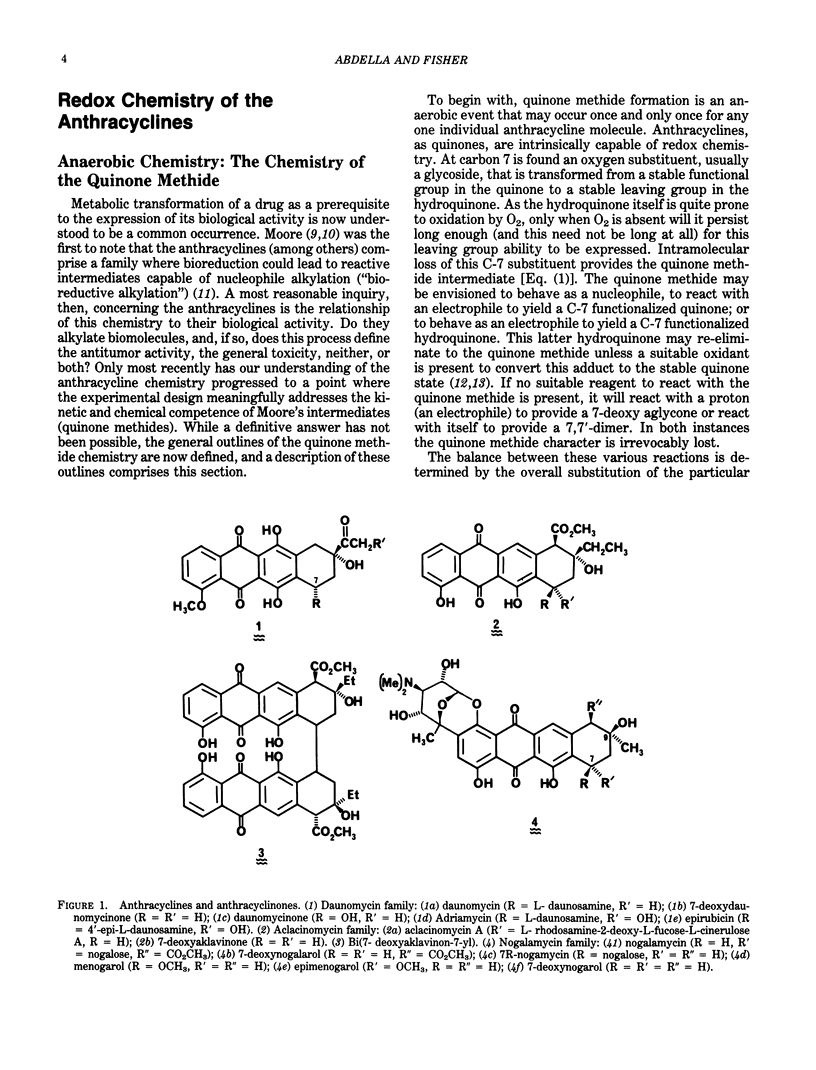
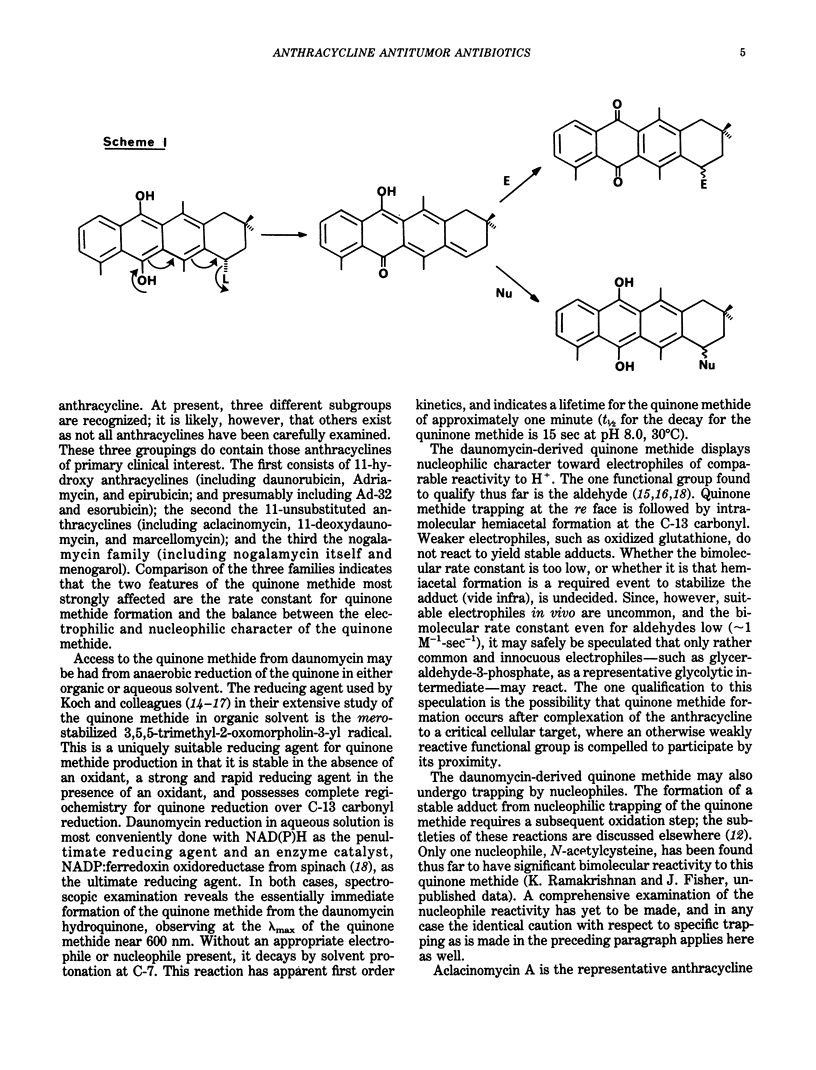
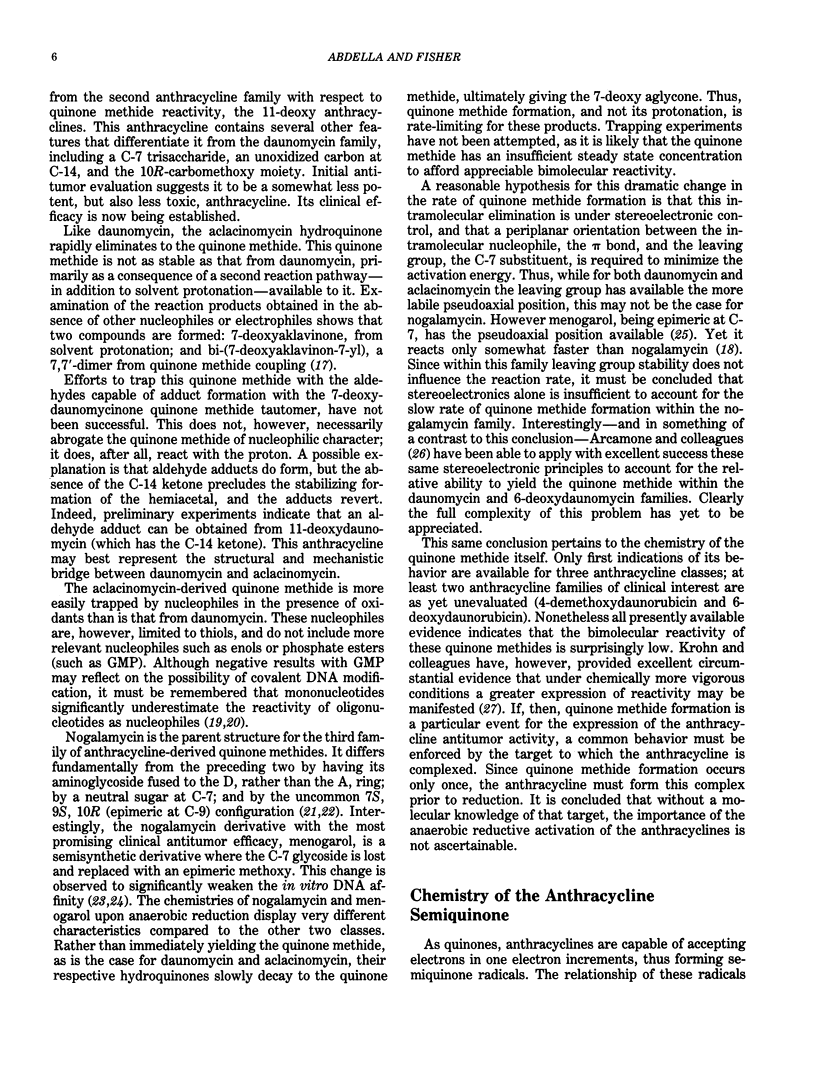
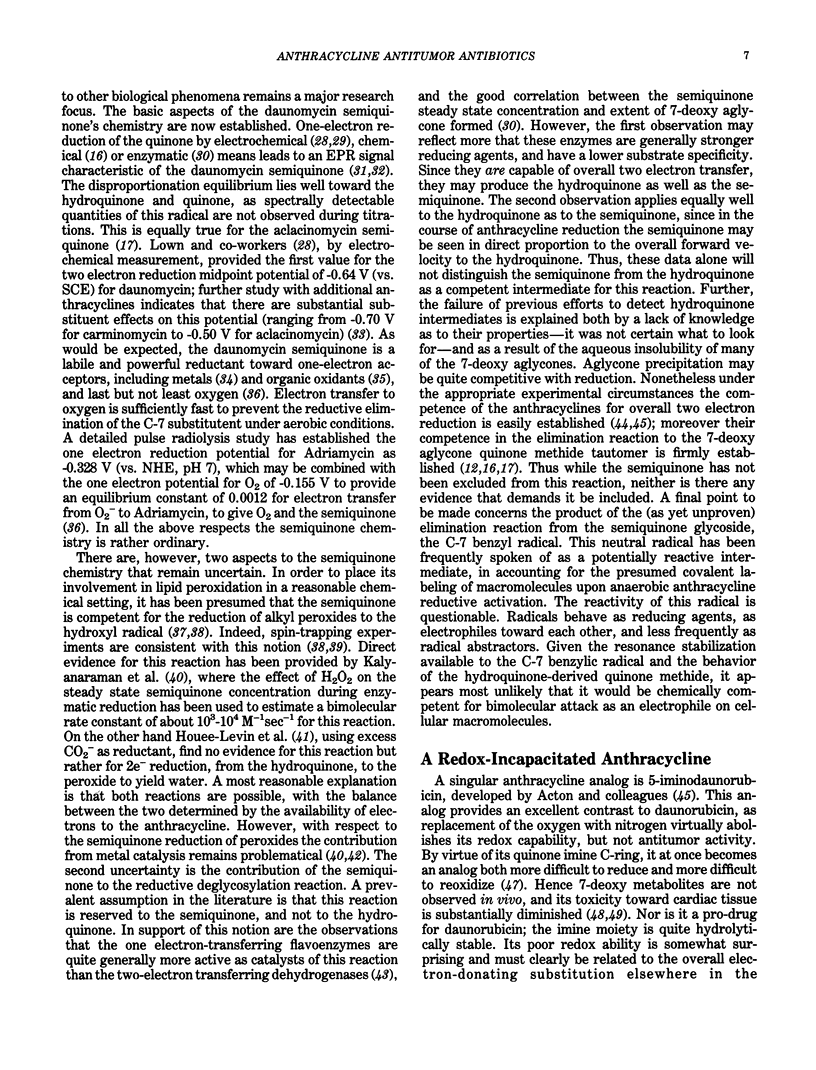
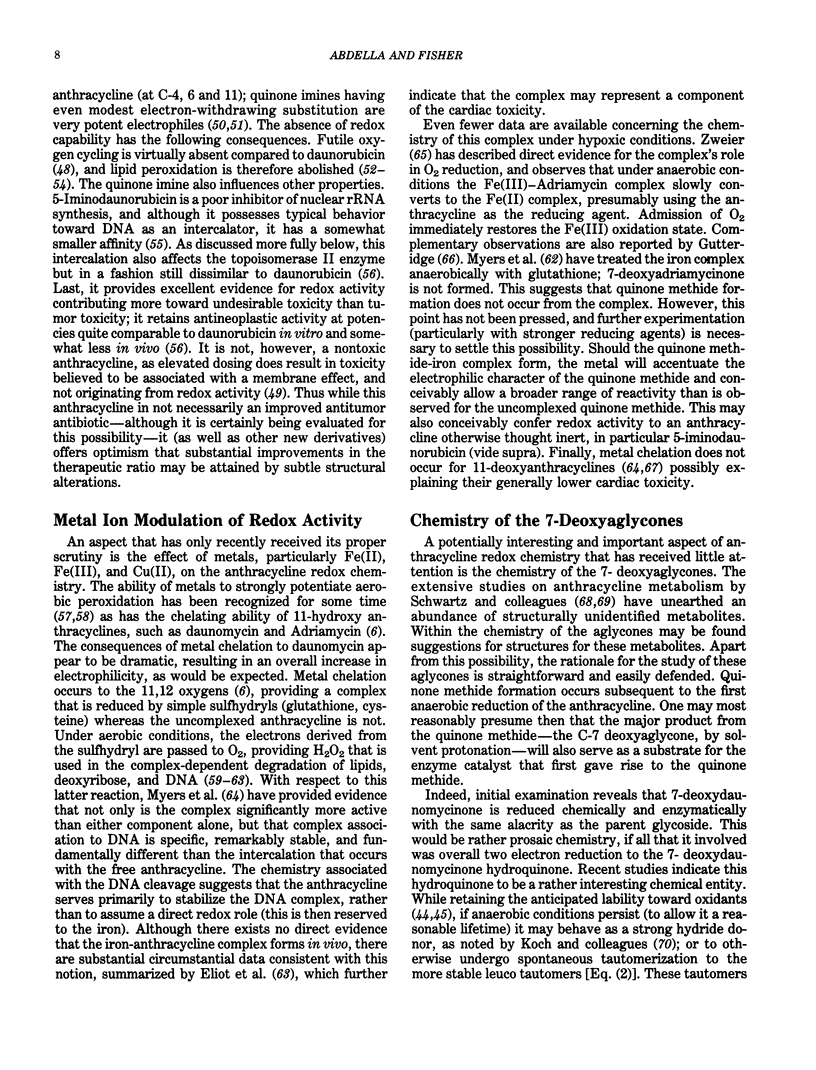
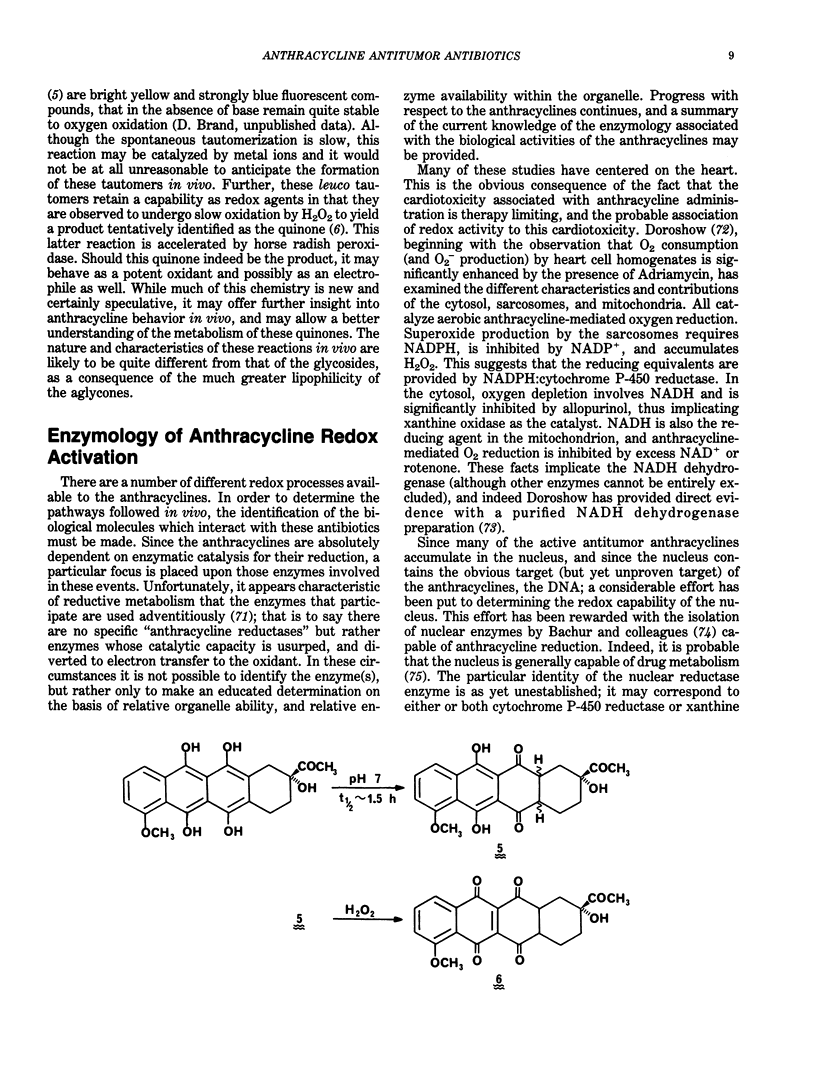
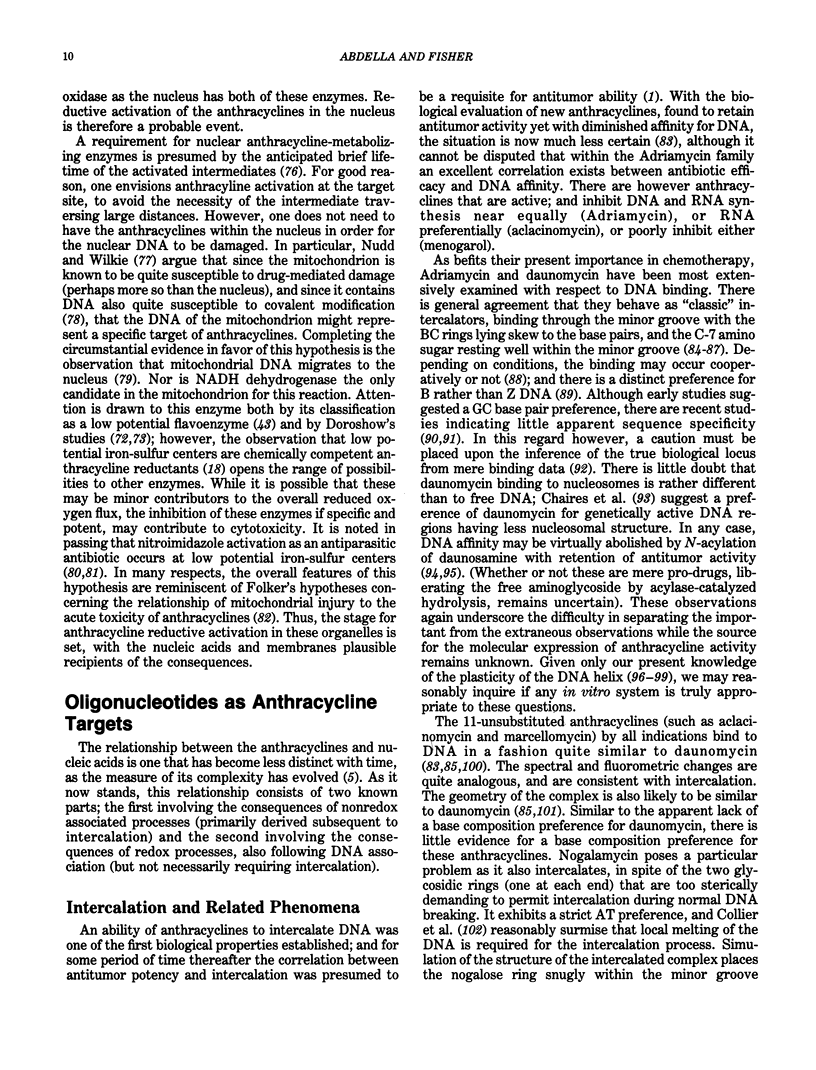

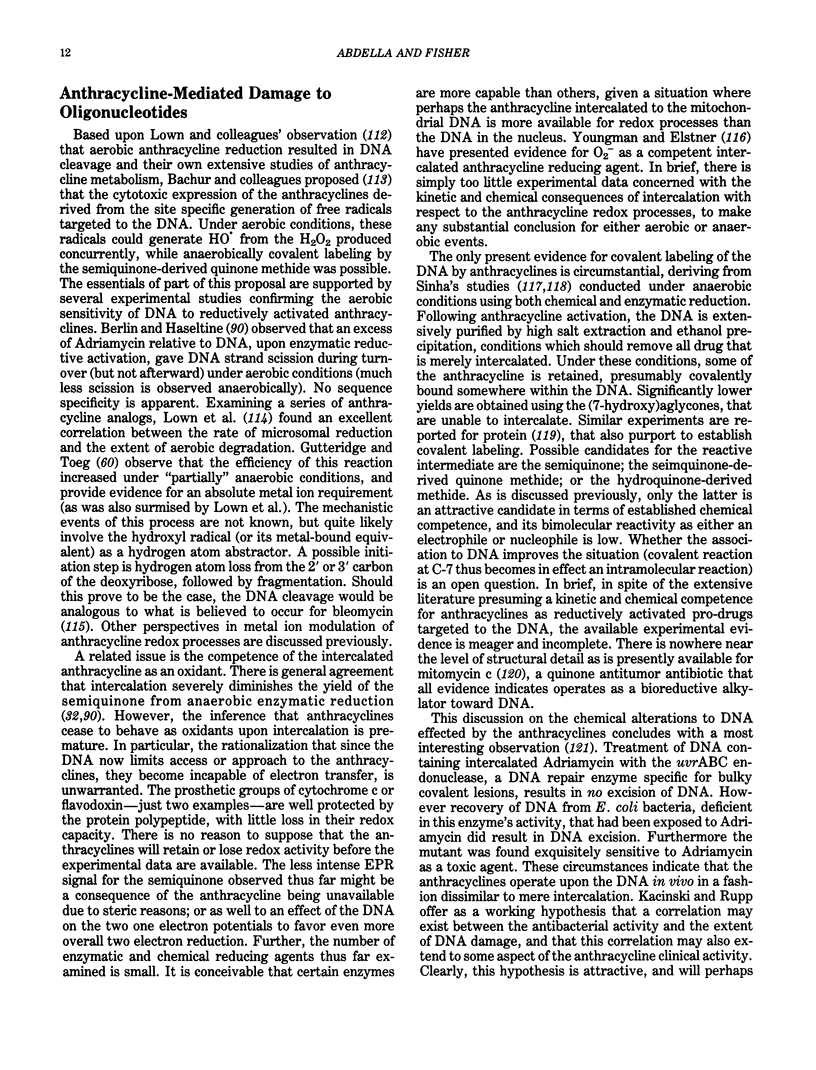
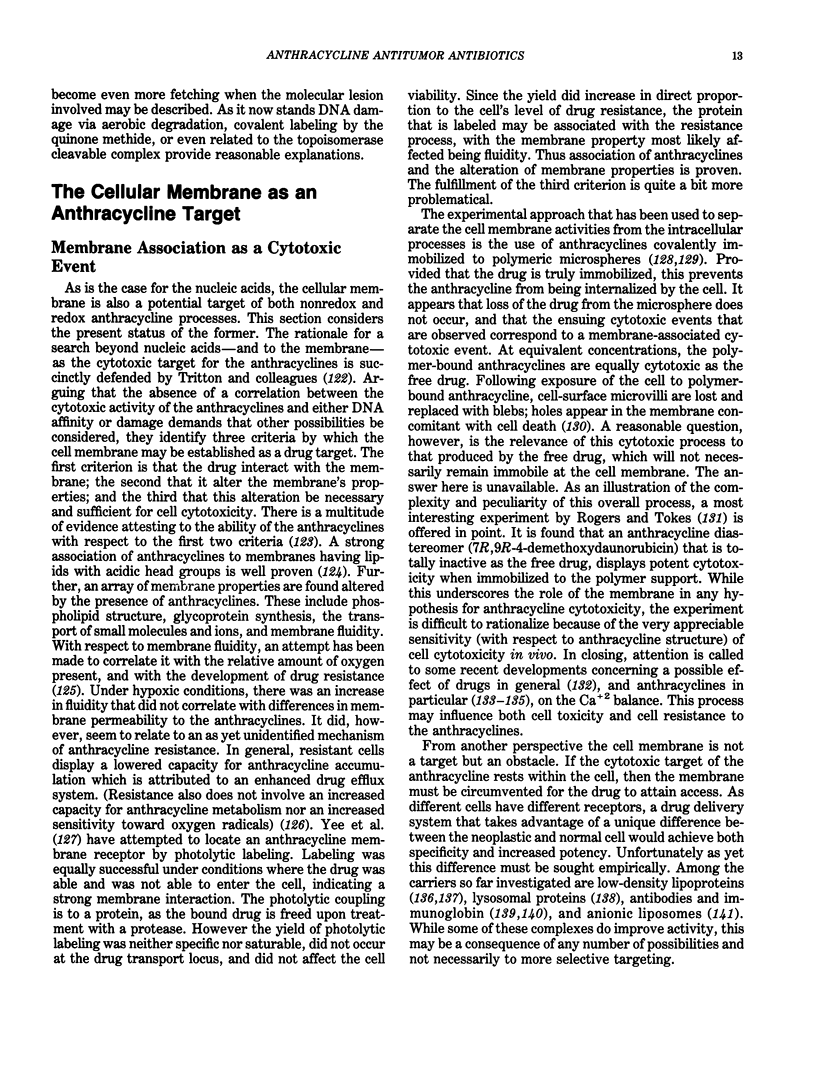
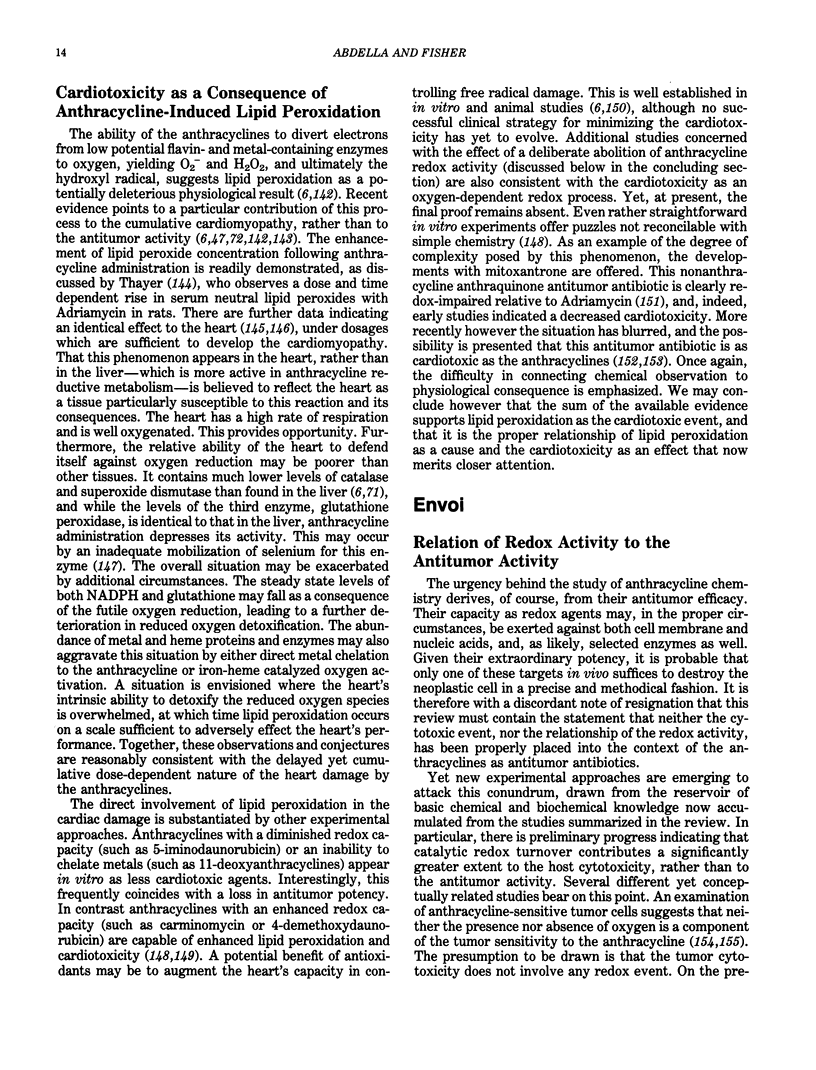
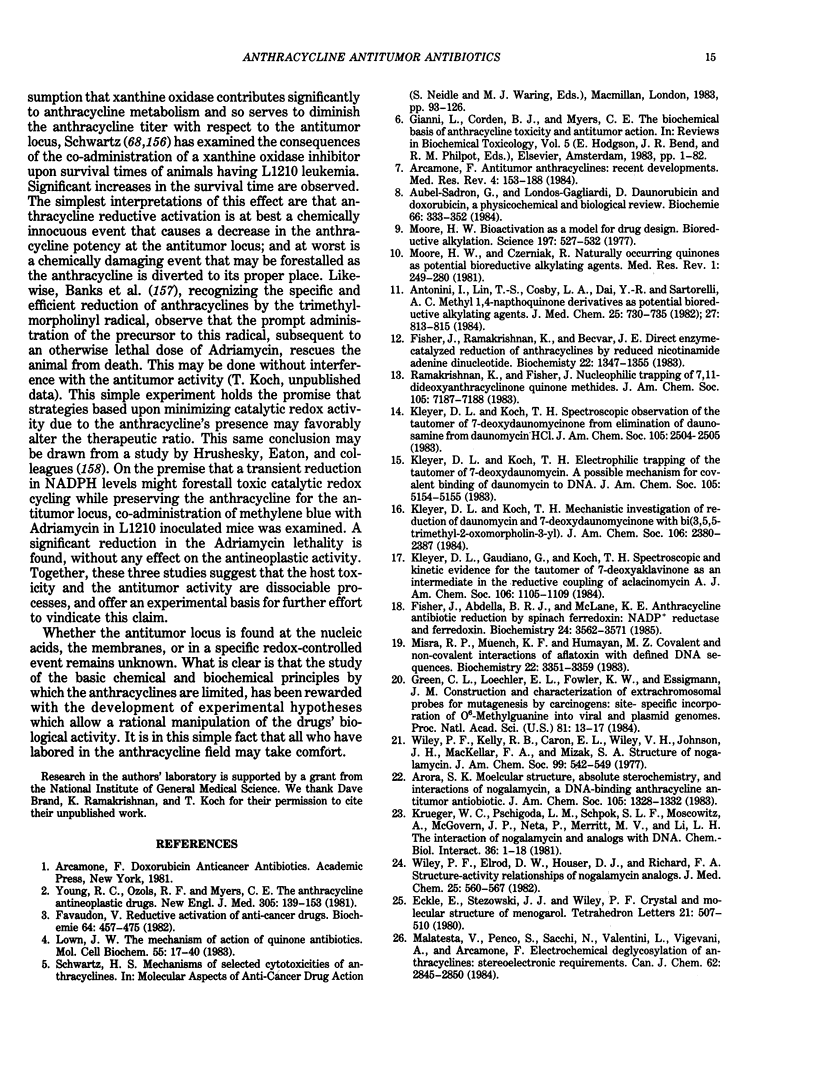
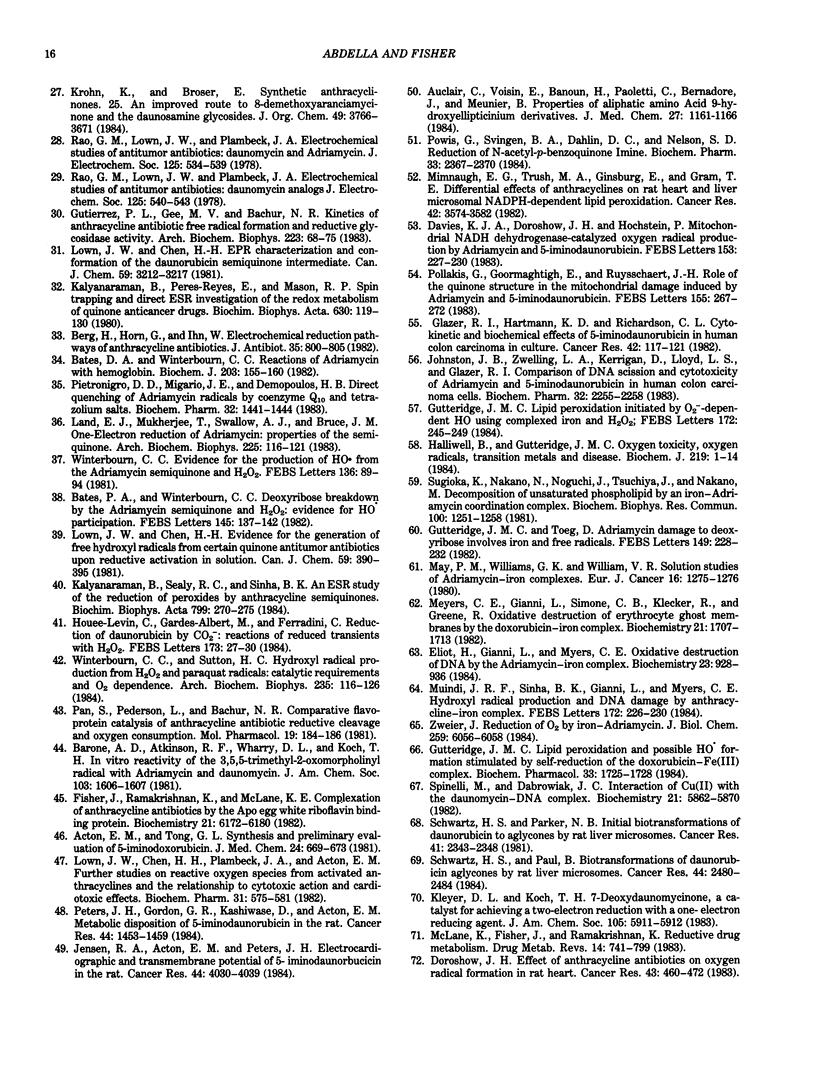
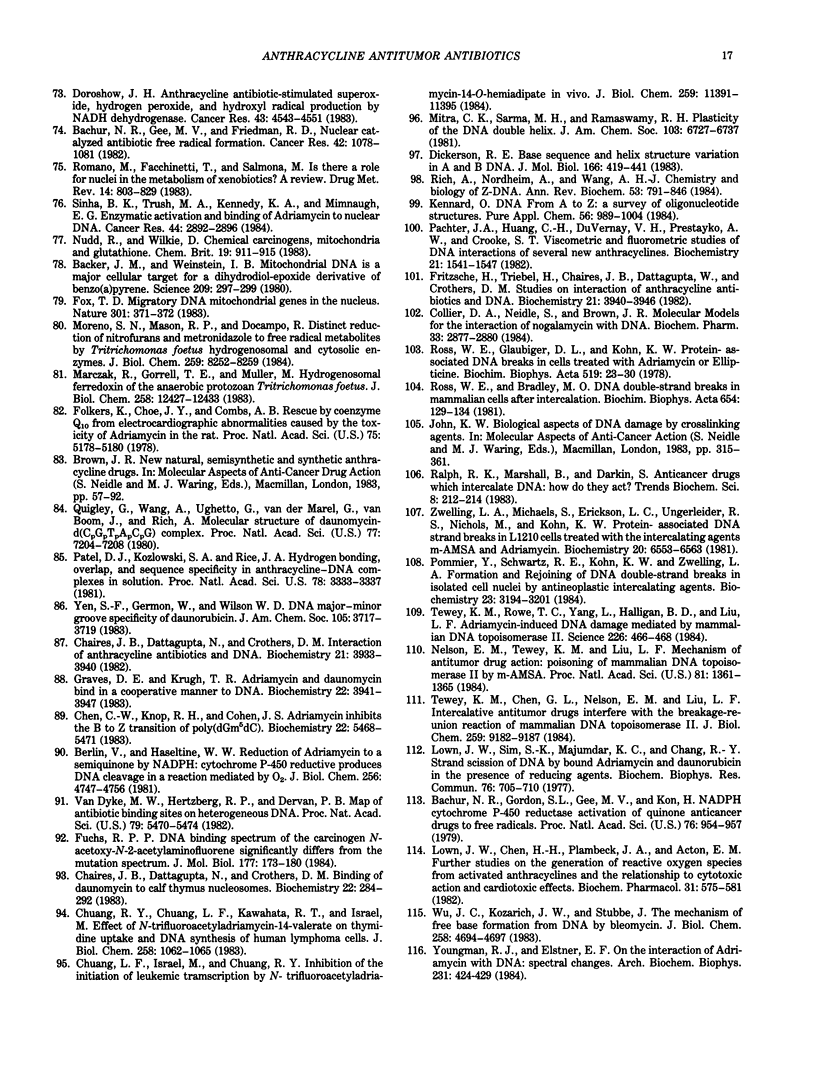
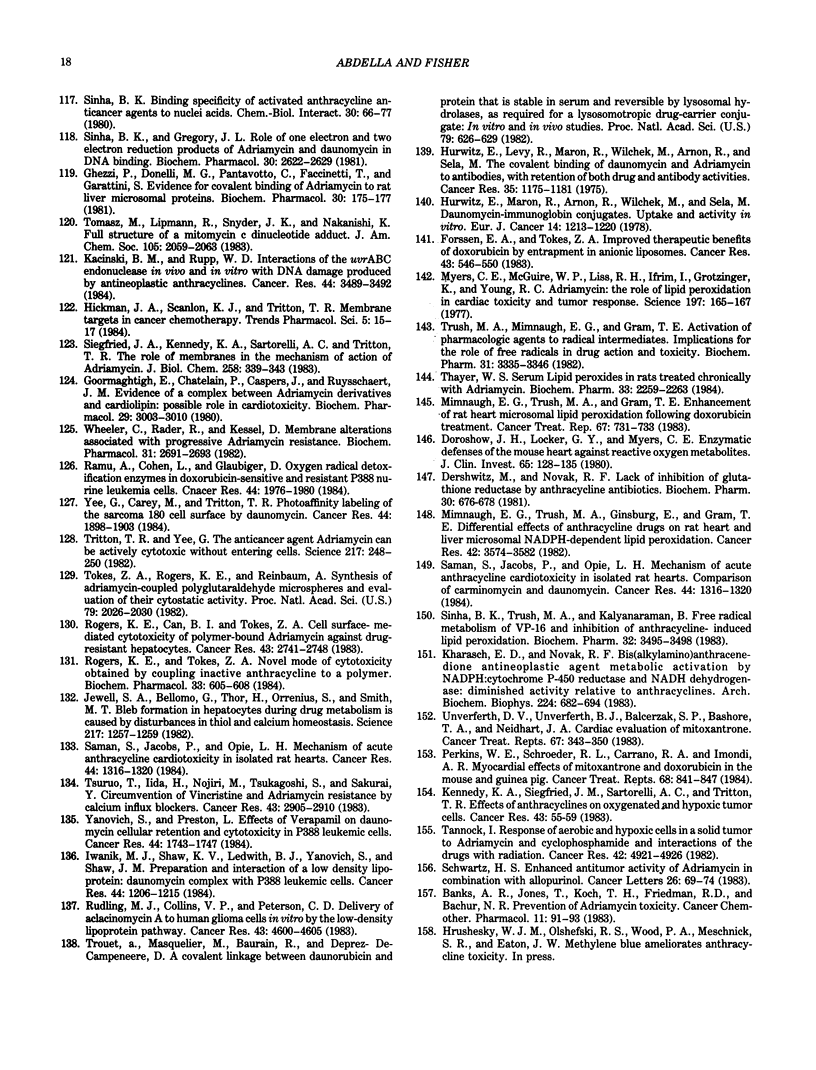
Selected References
These references are in PubMed. This may not be the complete list of references from this article.
- Acton E. M., Tong G. L. Synthesis and preliminary antitumor evaluation of 5-iminodoxorubicin. J Med Chem. 1981 Jun;24(6):669–673. doi: 10.1021/jm00138a005. [DOI] [PubMed] [Google Scholar]
- Antonini I., Lin T. S., Cosby L. A., Dai Y. R., Sartorelli A. C. 2- and 6-methyl-1,4-naphthoquinone derivatives and potential bioreductive alkylating agents. J Med Chem. 1982 Jun;25(6):730–735. doi: 10.1021/jm00348a023. [DOI] [PubMed] [Google Scholar]
- Arcamone F. Antitumor anthracyclines: recent developments. Med Res Rev. 1984 Apr-Jun;4(2):153–188. doi: 10.1002/med.2610040203. [DOI] [PubMed] [Google Scholar]
- Aubel-Sadron G., Londos-Gagliardi D. Daunorubicin and doxorubicin, anthracycline antibiotics, a physicochemical and biological review. Biochimie. 1984 May;66(5):333–352. doi: 10.1016/0300-9084(84)90018-x. [DOI] [PubMed] [Google Scholar]
- Auclair C., Voisin E., Banoun H., Paoletti C., Bernadou J., Meunier B. Potential antitumor agents: synthesis and biological properties of aliphatic amino acid 9-hydroxyellipticinium derivatives. J Med Chem. 1984 Sep;27(9):1161–1166. doi: 10.1021/jm00375a013. [DOI] [PubMed] [Google Scholar]
- Bachur N. R., Gee M. V., Friedman R. D. Nuclear catalyzed antibiotic free radical formation. Cancer Res. 1982 Mar;42(3):1078–1081. [PubMed] [Google Scholar]
- Bachur N. R., Gordon S. L., Gee M. V., Kon H. NADPH cytochrome P-450 reductase activation of quinone anticancer agents to free radicals. Proc Natl Acad Sci U S A. 1979 Feb;76(2):954–957. doi: 10.1073/pnas.76.2.954. [DOI] [PMC free article] [PubMed] [Google Scholar]
- Backer J. M., Weinstein I. B. Mitochondrial DNA is a major cellular target for a dihydrodiol-epoxide derivative of benzo[a]pyrene. Science. 1980 Jul 11;209(4453):297–299. doi: 10.1126/science.6770466. [DOI] [PubMed] [Google Scholar]
- Banks A. R., Jones T., Koch T. H., Friedman R. D., Bachur N. R. Prevention of adriamycin toxicity. Cancer Chemother Pharmacol. 1983;11(2):91–93. doi: 10.1007/BF00254252. [DOI] [PubMed] [Google Scholar]
- Bates D. A., Winterbourn C. C. Deoxyribose breakdown by the adriamycin semiquinone and H2O2: evidence for hydroxyl radical participation. FEBS Lett. 1982 Aug 16;145(1):137–142. doi: 10.1016/0014-5793(82)81222-2. [DOI] [PubMed] [Google Scholar]
- Bates D. A., Winterbourn C. C. Reactions of Adriamycin with haemoglobin. Superoxide dismutase indirectly inhibits reactions of the Adriamycin semiquinone. Biochem J. 1982 Apr 1;203(1):155–160. doi: 10.1042/bj2030155. [DOI] [PMC free article] [PubMed] [Google Scholar]
- Berg H., Horn G., Ihn W. Electrochemical reduction pathways of anthracycline antibiotics. J Antibiot (Tokyo) 1982 Jul;35(7):800–805. doi: 10.7164/antibiotics.35.800. [DOI] [PubMed] [Google Scholar]
- Berlin V., Haseltine W. A. Reduction of adriamycin to a semiquinone-free radical by NADPH cytochrome P-450 reductase produces DNA cleavage in a reaction mediated by molecular oxygen. J Biol Chem. 1981 May 25;256(10):4747–4756. [PubMed] [Google Scholar]
- Chaires J. B., Dattagupta N., Crothers D. M. Binding of daunomycin to calf thymus nucleosomes. Biochemistry. 1983 Jan 18;22(2):284–292. doi: 10.1021/bi00271a009. [DOI] [PubMed] [Google Scholar]
- Chaires J. B., Dattagupta N., Crothers D. M. Studies on interaction of anthracycline antibiotics and deoxyribonucleic acid: equilibrium binding studies on interaction of daunomycin with deoxyribonucleic acid. Biochemistry. 1982 Aug 17;21(17):3933–3940. doi: 10.1021/bi00260a005. [DOI] [PubMed] [Google Scholar]
- Chuang L. F., Israel M., Chuang R. Y. Inhibition of the initiation of leukemic transcription by N-trifluoroacetyladriamycin-14-O-hemiadipate in vitro. Impaired formation of RNA polymerase-DNA complex. J Biol Chem. 1984 Sep 25;259(18):11391–11395. [PubMed] [Google Scholar]
- Chuang R. Y., Chuang L. F., Kawahata R. T., Israel M. Effect of N-trifluoroacetyladriamycin-14-valerate on [3H]thymidine uptake and DNA synthesis of human lymphoma cells. J Biol Chem. 1983 Jan 25;258(2):1062–1065. [PubMed] [Google Scholar]
- Collier D. A., Neidle S., Brown J. R. Molecular models for the interaction of the anti-tumour drug nogalamycin with DNA. Biochem Pharmacol. 1984 Sep 15;33(18):2877–2880. doi: 10.1016/0006-2952(84)90210-7. [DOI] [PubMed] [Google Scholar]
- Davies K. J., Doroshow J. H., Hochstein P. Mitochondrial NADH dehydrogenase-catalyzed oxygen radical production by adriamycin, and the relative inactivity of 5-iminodaunorubicin. FEBS Lett. 1983 Mar 7;153(1):227–230. doi: 10.1016/0014-5793(83)80153-7. [DOI] [PubMed] [Google Scholar]
- Dershwitz M., Novak R. F. Lack of inhibition of glutathione reductase by anthracycline antibiotics. Biochem Pharmacol. 1981 Mar 15;30(6):676–678. doi: 10.1016/0006-2952(81)90148-9. [DOI] [PubMed] [Google Scholar]
- Dickerson R. E. Base sequence and helix structure variation in B and A DNA. J Mol Biol. 1983 May 25;166(3):419–441. doi: 10.1016/s0022-2836(83)80093-x. [DOI] [PubMed] [Google Scholar]
- Doroshow J. H. Anthracycline antibiotic-stimulated superoxide, hydrogen peroxide, and hydroxyl radical production by NADH dehydrogenase. Cancer Res. 1983 Oct;43(10):4543–4551. [PubMed] [Google Scholar]
- Doroshow J. H. Effect of anthracycline antibiotics on oxygen radical formation in rat heart. Cancer Res. 1983 Feb;43(2):460–472. [PubMed] [Google Scholar]
- Doroshow J. H., Locker G. Y., Myers C. E. Enzymatic defenses of the mouse heart against reactive oxygen metabolites: alterations produced by doxorubicin. J Clin Invest. 1980 Jan;65(1):128–135. doi: 10.1172/JCI109642. [DOI] [PMC free article] [PubMed] [Google Scholar]
- Eliot H., Gianni L., Myers C. Oxidative destruction of DNA by the adriamycin-iron complex. Biochemistry. 1984 Feb 28;23(5):928–936. doi: 10.1021/bi00300a021. [DOI] [PubMed] [Google Scholar]
- Favaudon V. On the mechanism of reductive activation in the mode of action of some anticancer drugs. Biochimie. 1982 Jul;64(7):457–475. doi: 10.1016/s0300-9084(82)80162-4. [DOI] [PubMed] [Google Scholar]
- Fisher J., Abdella B. R., McLane K. E. Anthracycline antibiotic reduction by spinach ferredoxin-NADP+ reductase and ferredoxin. Biochemistry. 1985 Jul 2;24(14):3562–3571. doi: 10.1021/bi00335a026. [DOI] [PubMed] [Google Scholar]
- Fisher J., Ramakrishnan K., Becvar J. E. Direct enzyme-catalyzed reduction of anthracyclines by reduced nicotinamide adenine dinucleotide. Biochemistry. 1983 Mar 15;22(6):1347–1355. doi: 10.1021/bi00275a005. [DOI] [PubMed] [Google Scholar]
- Fisher J., Ramakrishnan K., McLane K. E. Complexation of anthracycline antibiotics by the apo egg white riboflavin binding protein. Biochemistry. 1982 Nov 23;21(24):6172–6180. doi: 10.1021/bi00267a023. [DOI] [PubMed] [Google Scholar]
- Folkers K., Choe J. Y., Combs A. B. Rescue by coenzyme Q10 from electrocardiographic abnormalities caused by the toxicity of adriamycin in the rat. Proc Natl Acad Sci U S A. 1978 Oct;75(10):5178–5180. doi: 10.1073/pnas.75.10.5178. [DOI] [PMC free article] [PubMed] [Google Scholar]
- Forssen E. A., Tökés Z. A. Improved therapeutic benefits of doxorubicin by entrapment in anionic liposomes. Cancer Res. 1983 Feb;43(2):546–550. [PubMed] [Google Scholar]
- Fox T. D. Mitochondrial genes in the nucleus. Nature. 1983 Feb 3;301(5899):371–372. doi: 10.1038/301371a0. [DOI] [PubMed] [Google Scholar]
- Fritzsche H., Triebel H., Chaires J. B., Dattagupta N., Crothers D. M. Studies on interaction of anthracycline antibiotics and deoxyribonucleic acid: geometry of intercalation of iremycin and daunomycin. Biochemistry. 1982 Aug 17;21(17):3940–3946. doi: 10.1021/bi00260a006. [DOI] [PubMed] [Google Scholar]
- Fuchs R. P. DNA binding spectrum of the carcinogen N-acetoxy-N-2-acetylaminofluorene significantly differs from the mutation spectrum. J Mol Biol. 1984 Jul 25;177(1):173–180. doi: 10.1016/0022-2836(84)90063-9. [DOI] [PubMed] [Google Scholar]
- Ghezzi P., Donelli M. G., Pantarotto C., Facchinetti T., Garattini S. Evidence for covalent binding of adriamycin to rat liver microsomal proteins. Biochem Pharmacol. 1981 Jan 15;30(2):175–177. doi: 10.1016/0006-2952(81)90191-x. [DOI] [PubMed] [Google Scholar]
- Glazer R. I., Hartman K. D., Richardson C. L. Cytokinetic and biochemical effects of 5-iminodaunorubicin in human colon carcinoma in culture. Cancer Res. 1982 Jan;42(1):117–121. [PubMed] [Google Scholar]
- Goormaghtigh E., Chatelain P., Caspers J., Ruysschaert J. M. Evidence of a complex between adriamycin derivatives and cardiolipin: possible role in cardiotoxicity. Biochem Pharmacol. 1980 Nov 1;29(21):3003–3010. doi: 10.1016/0006-2952(80)90050-7. [DOI] [PubMed] [Google Scholar]
- Graves D. E., Krugh T. R. Adriamycin and daunorubicin bind in a cooperative manner to deoxyribonucleic acid. Biochemistry. 1983 Aug 2;22(16):3941–3947. doi: 10.1021/bi00285a033. [DOI] [PubMed] [Google Scholar]
- Green C. L., Loechler E. L., Fowler K. W., Essigmann J. M. Construction and characterization of extrachromosomal probes for mutagenesis by carcinogens: site-specific incorporation of O6-methylguanine into viral and plasmid genomes. Proc Natl Acad Sci U S A. 1984 Jan;81(1):13–17. doi: 10.1073/pnas.81.1.13. [DOI] [PMC free article] [PubMed] [Google Scholar]
- Gutiérrez P. L., Gee M. V., Bachur N. R. Kinetics of anthracycline antibiotic free radical formation and reductive glycosidase activity. Arch Biochem Biophys. 1983 May;223(1):68–75. doi: 10.1016/0003-9861(83)90572-6. [DOI] [PubMed] [Google Scholar]
- Gutteridge J. M. Lipid peroxidation and possible hydroxyl radical formation stimulated by the self-reduction of a doxorubicin-iron (III) complex. Biochem Pharmacol. 1984 Jun 1;33(11):1725–1728. doi: 10.1016/0006-2952(84)90340-x. [DOI] [PubMed] [Google Scholar]
- Gutteridge J. M. Lipid peroxidation initiated by superoxide-dependent hydroxyl radicals using complexed iron and hydrogen peroxide. FEBS Lett. 1984 Jul 9;172(2):245–249. doi: 10.1016/0014-5793(84)81134-5. [DOI] [PubMed] [Google Scholar]
- Halliwell B., Gutteridge J. M. Oxygen toxicity, oxygen radicals, transition metals and disease. Biochem J. 1984 Apr 1;219(1):1–14. doi: 10.1042/bj2190001. [DOI] [PMC free article] [PubMed] [Google Scholar]
- Houée-Levin C., Gardès-Albert M., Ferradini C. Reduction of daunorubicin aqueous solutions by COO.- free radicals. Reactions of reduced transients with H2O2. FEBS Lett. 1984 Jul 23;173(1):27–30. doi: 10.1016/0014-5793(84)81010-8. [DOI] [PubMed] [Google Scholar]
- Hurwitz E., Levy R., Maron R., Wilchek M., Arnon R., Sela M. The covalent binding of daunomycin and adriamycin to antibodies, with retention of both drug and antibody activities. Cancer Res. 1975 May;35(5):1175–1181. [PubMed] [Google Scholar]
- Hurwitz E., Maron R., Arnon R., Wilchek M., Sela M. Daunomycin--immunoglobulin conjugates, uptake and activity in vitro. Eur J Cancer. 1978 Nov;14(11):1213–1220. doi: 10.1016/0014-2964(78)90227-x. [DOI] [PubMed] [Google Scholar]
- Iwanik M. J., Shaw K. V., Ledwith B. J., Yanovich S., Shaw J. M. Preparation and interaction of a low-density lipoprotein:daunomycin complex with P388 leukemic cells. Cancer Res. 1984 Mar;44(3):1206–1215. [PubMed] [Google Scholar]
- Jensen R. A., Acton E. M., Peters J. H. Electrocardiographic and transmembrane potential effects of 5-iminodaunorubicin in the rat. Cancer Res. 1984 Sep;44(9):4030–4039. [PubMed] [Google Scholar]
- Jewell S. A., Bellomo G., Thor H., Orrenius S., Smith M. Bleb formation in hepatocytes during drug metabolism is caused by disturbances in thiol and calcium ion homeostasis. Science. 1982 Sep 24;217(4566):1257–1259. doi: 10.1126/science.7112127. [DOI] [PubMed] [Google Scholar]
- Johnston J. B., Zwelling L. A., Kerrigan D., Lloyd L. S., Glazer R. I. Comparison of DNA scission and cytotoxicity produced by Adriamycin and 5-iminodaunorubicin in human colon carcinoma cells. Biochem Pharmacol. 1983 Jul 15;32(14):2255–2258. doi: 10.1016/0006-2952(83)90235-6. [DOI] [PubMed] [Google Scholar]
- Kacinski B. M., Rupp W. D. Interactions of the UVRABC endonuclease in vivo and in vitro with DNA damage produced by antineoplastic anthracyclines. Cancer Res. 1984 Aug;44(8):3489–3492. [PubMed] [Google Scholar]
- Kalyanaraman B., Perez-Reyes E., Mason R. P. Spin-trapping and direct electron spin resonance investigations of the redox metabolism of quinone anticancer drugs. Biochim Biophys Acta. 1980 Jun 5;630(1):119–130. doi: 10.1016/0304-4165(80)90142-7. [DOI] [PubMed] [Google Scholar]
- Kalyanaraman B., Sealy R. C., Sinha B. K. An electron spin resonance study of the reduction of peroxides by anthracycline semiquinones. Biochim Biophys Acta. 1984 Jun 29;799(3):270–275. doi: 10.1016/0304-4165(84)90270-8. [DOI] [PubMed] [Google Scholar]
- Kennedy K. A., Siegfried J. M., Sartorelli A. C., Tritton T. R. Effects of anthracyclines on oxygenated and hypoxic tumor cells. Cancer Res. 1983 Jan;43(1):54–59. [PubMed] [Google Scholar]
- Kharasch E. D., Novak R. F. Bis(alkylamino)anthracenedione antineoplastic agent metabolic activation by NADPH-cytochrome P-450 reductase and NADH dehydrogenase: diminished activity relative to anthracyclines. Arch Biochem Biophys. 1983 Jul 15;224(2):682–694. doi: 10.1016/0003-9861(83)90256-4. [DOI] [PubMed] [Google Scholar]
- Land E. J., Mukherjee T., Swallow A. J., Bruce J. M. One-electron reduction of adriamycin: properties of the semiquinone. Arch Biochem Biophys. 1983 Aug;225(1):116–121. doi: 10.1016/0003-9861(83)90013-9. [DOI] [PubMed] [Google Scholar]
- Lown J. W., Chen H. H., Plambeck J. A., Acton E. M. Further studies on the generation of reactive oxygen species from activated anthracyclines and the relationship to cytotoxic action and cardiotoxic effects. Biochem Pharmacol. 1982 Feb 15;31(4):575–581. doi: 10.1016/0006-2952(82)90162-9. [DOI] [PubMed] [Google Scholar]
- Lown J. W., Chen H. H., Plambeck J. A., Acton E. M. Further studies on the generation of reactive oxygen species from activated anthracyclines and the relationship to cytotoxic action and cardiotoxic effects. Biochem Pharmacol. 1982 Feb 15;31(4):575–581. doi: 10.1016/0006-2952(82)90162-9. [DOI] [PubMed] [Google Scholar]
- Lown J. W., Sim S. K., Majumdar K. C., Chang R. Y. Strand scission of DNA by bound adriamycin and daunorubicin in the presence of reducing agents. Biochem Biophys Res Commun. 1977 Jun 6;76(3):705–710. doi: 10.1016/0006-291x(77)91557-1. [DOI] [PubMed] [Google Scholar]
- Lown J. W. The mechanism of action of quinone antibiotics. Mol Cell Biochem. 1983;55(1):17–40. doi: 10.1007/BF00229240. [DOI] [PubMed] [Google Scholar]
- Marczak R., Gorrell T. E., Müller M. Hydrogenosomal ferredoxin of the anaerobic protozoon, Tritrichomonas foetus. J Biol Chem. 1983 Oct 25;258(20):12427–12433. [PubMed] [Google Scholar]
- May P. M., Williams G. K., Williams D. R. Solution chemistry studies of adriamycin--iron complexes present in vivo. Eur J Cancer. 1980 Sep;16(9):1275–1276. doi: 10.1016/0014-2964(80)90189-9. [DOI] [PubMed] [Google Scholar]
- Mc Lane K. E., Fisher J., Ramakrishnan K. Reductive drug metabolism. Drug Metab Rev. 1983;14(4):741–799. doi: 10.3109/03602538308991408. [DOI] [PubMed] [Google Scholar]
- Mimnaugh E. G., Trush M. A., Ginsburg E., Gram T. E. Differential effects of anthracycline drugs on rat heart and liver microsomal reduced nicotinamide adenine dinucleotide phosphate-dependent lipid peroxidation. Cancer Res. 1982 Sep;42(9):3574–3582. [PubMed] [Google Scholar]
- Mimnaugh E. G., Trush M. A., Ginsburg E., Gram T. E. Differential effects of anthracycline drugs on rat heart and liver microsomal reduced nicotinamide adenine dinucleotide phosphate-dependent lipid peroxidation. Cancer Res. 1982 Sep;42(9):3574–3582. [PubMed] [Google Scholar]
- Mimnaugh E. G., Trush M. A., Gram T. E. Enhancement of rat heart microsomal lipid peroxidation following doxorubicin treatment in vivo. Cancer Treat Rep. 1983 Jul-Aug;67(7-8):731–733. [PubMed] [Google Scholar]
- Misra R. P., Muench K. F., Humayun M. Z. Covalent and noncovalent interactions of aflatoxin with defined deoxyribonucleic acid sequences. Biochemistry. 1983 Jul 5;22(14):3351–3359. doi: 10.1021/bi00283a008. [DOI] [PubMed] [Google Scholar]
- Moore H. W. Bioactivation as a model for drug design bioreductive alkylation. Science. 1977 Aug 5;197(4303):527–532. doi: 10.1126/science.877572. [DOI] [PubMed] [Google Scholar]
- Moore H. W., Czerniak R. Naturally occurring quinones as potential bioreductive alkylating agents. Med Res Rev. 1981 Fall;1(3):249–280. doi: 10.1002/med.2610010303. [DOI] [PubMed] [Google Scholar]
- Moreno S. N., Mason R. P., Docampo R. Distinct reduction of nitrofurans and metronidazole to free radical metabolites by Tritrichomonas foetus hydrogenosomal and cytosolic enzymes. J Biol Chem. 1984 Jul 10;259(13):8252–8259. [PubMed] [Google Scholar]
- Muindi J. R., Sinha B. K., Gianni L., Myers C. E. Hydroxyl radical production and DNA damage induced by anthracycline-iron complex. FEBS Lett. 1984 Jul 9;172(2):226–230. doi: 10.1016/0014-5793(84)81130-8. [DOI] [PubMed] [Google Scholar]
- Myers C. E., Gianni L., Simone C. B., Klecker R., Greene R. Oxidative destruction of erythrocyte ghost membranes catalyzed by the doxorubicin-iron complex. Biochemistry. 1982 Apr 13;21(8):1707–1712. doi: 10.1021/bi00537a001. [DOI] [PubMed] [Google Scholar]
- Myers C. E., McGuire W. P., Liss R. H., Ifrim I., Grotzinger K., Young R. C. Adriamycin: the role of lipid peroxidation in cardiac toxicity and tumor response. Science. 1977 Jul 8;197(4299):165–167. doi: 10.1126/science.877547. [DOI] [PubMed] [Google Scholar]
- Nelson E. M., Tewey K. M., Liu L. F. Mechanism of antitumor drug action: poisoning of mammalian DNA topoisomerase II on DNA by 4'-(9-acridinylamino)-methanesulfon-m-anisidide. Proc Natl Acad Sci U S A. 1984 Mar;81(5):1361–1365. doi: 10.1073/pnas.81.5.1361. [DOI] [PMC free article] [PubMed] [Google Scholar]
- Pachter J. A., Huang C. H., DuVernay V. H., Jr, Prestayko A. W., Crooke S. T. Viscometric and fluorometric studies of deoxyribonucleic acid interactions of several new anthracyclines. Biochemistry. 1982 Mar 30;21(7):1541–1547. doi: 10.1021/bi00536a012. [DOI] [PubMed] [Google Scholar]
- Pan S. S., Pedersen L., Bachur N. R. Comparative flavoprotein catalysis of anthracycline antibiotic. Reductive cleavage and oxygen consumption. Mol Pharmacol. 1981 Jan;19(1):184–186. [PubMed] [Google Scholar]
- Patel D. J., Kozlowski S. A., Rice J. A. Hydrogen bonding, overlap geometry, and sequence specificity in anthracycline antitumor antibiotic.DNA complexes in solution. Proc Natl Acad Sci U S A. 1981 Jun;78(6):3333–3337. doi: 10.1073/pnas.78.6.3333. [DOI] [PMC free article] [PubMed] [Google Scholar]
- Perkins W. E., Schroeder R. L., Carrano R. A., Imondi A. R. Myocardial effects of mitoxantrone and doxorubicin in the mouse and guinea pig. Cancer Treat Rep. 1984 Jun;68(6):841–847. [PubMed] [Google Scholar]
- Peters J. H., Gordon G. R., Kashiwase D., Acton E. M. Metabolic disposition of 5-iminodaunorubicin in the rat. Cancer Res. 1984 Apr;44(4):1453–1459. [PubMed] [Google Scholar]
- Pietronigro D. D., Mignano J. E., Demopoulos H. B. Direct quenching of adriamycin radicals by coenzyme Q10 and tetrazolium salts. Biochem Pharmacol. 1983 Apr 15;32(8):1441–1444. doi: 10.1016/0006-2952(83)90459-8. [DOI] [PubMed] [Google Scholar]
- Pollakis G., Goormaghtigh E., Ruysschaert J. M. Role of the quinone structure in the mitochondrial damage induced by antitumor anthracyclines. Comparison of adriamycin and 5-iminodaunorubicin. FEBS Lett. 1983 May 8;155(2):267–272. doi: 10.1016/0014-5793(82)80618-2. [DOI] [PubMed] [Google Scholar]
- Pommier Y., Schwartz R. E., Kohn K. W., Zwelling L. A. Formation and rejoining of deoxyribonucleic acid double-strand breaks induced in isolated cell nuclei by antineoplastic intercalating agents. Biochemistry. 1984 Jul 3;23(14):3194–3201. doi: 10.1021/bi00309a013. [DOI] [PubMed] [Google Scholar]
- Powis G., Svingen B. A., Dahlin D. C., Nelson S. D. Enzymatic and non-enzymatic reduction of N-acetyl-p-benzoquinone imine and some properties of the N-acetyl-p-benzosemiquinone imine radical. Biochem Pharmacol. 1984 Aug 1;33(15):2367–2370. doi: 10.1016/0006-2952(84)90707-x. [DOI] [PubMed] [Google Scholar]
- Quigley G. J., Wang A. H., Ughetto G., van der Marel G., van Boom J. H., Rich A. Molecular structure of an anticancer drug-DNA complex: daunomycin plus d(CpGpTpApCpG). Proc Natl Acad Sci U S A. 1980 Dec;77(12):7204–7208. doi: 10.1073/pnas.77.12.7204. [DOI] [PMC free article] [PubMed] [Google Scholar]
- Ramu A., Cohen L., Glaubiger D. Oxygen radical detoxification enzymes in doxorubicin-sensitive and -resistant P388 murine leukemia cells. Cancer Res. 1984 May;44(5):1976–1980. [PubMed] [Google Scholar]
- Rich A., Nordheim A., Wang A. H. The chemistry and biology of left-handed Z-DNA. Annu Rev Biochem. 1984;53:791–846. doi: 10.1146/annurev.bi.53.070184.004043. [DOI] [PubMed] [Google Scholar]
- Rogers K. E., Carr B. I., Tökés Z. A. Cell surface-mediated cytotoxicity of polymer-bound Adriamycin against drug-resistant hepatocytes. Cancer Res. 1983 Jun;43(6):2741–2748. [PubMed] [Google Scholar]
- Rogers K. E., Tökés Z. A. Novel mode of cytotoxicity obtained by coupling inactive anthracycline to a polymer. Biochem Pharmacol. 1984 Feb 15;33(4):605–608. doi: 10.1016/0006-2952(84)90315-0. [DOI] [PubMed] [Google Scholar]
- Romano M., Facchinetti T., Salmona M. Is there a role for nuclei in the metabolism of xenobiotica? A review. Drug Metab Rev. 1983;14(4):803–829. doi: 10.3109/03602538308991409. [DOI] [PubMed] [Google Scholar]
- Ross W. E., Bradley M. O. DNA double-stranded breaks in mammalian cells after exposure to intercalating agents. Biochim Biophys Acta. 1981 Jun 26;654(1):129–134. doi: 10.1016/0005-2787(81)90145-3. [DOI] [PubMed] [Google Scholar]
- Ross W. E., Glaubiger D. L., Kohn K. W. Protein-associated DNA breaks in cells treated with adriamycin or ellipticine. Biochim Biophys Acta. 1978 Jun 22;519(1):23–30. doi: 10.1016/0005-2787(78)90059-x. [DOI] [PubMed] [Google Scholar]
- Rudling M. J., Collins V. P., Peterson C. O. Delivery of aclacinomycin A to human glioma cells in vitro by the low-density lipoprotein pathway. Cancer Res. 1983 Oct;43(10):4600–4605. [PubMed] [Google Scholar]
- Saman S., Jacobs P., Opie L. H. Mechanism of acute anthracycline cardiotoxicity in isolated rat hearts: carminomycin versus daunomycin. Cancer Res. 1984 Apr;44(4):1316–1320. [PubMed] [Google Scholar]
- Saman S., Jacobs P., Opie L. H. Mechanism of acute anthracycline cardiotoxicity in isolated rat hearts: carminomycin versus daunomycin. Cancer Res. 1984 Apr;44(4):1316–1320. [PubMed] [Google Scholar]
- Schwartz H. S. Enhanced antitumor activity of adriamycin in combination with allopurinol. Cancer Lett. 1983 Aug;20(1):69–74. doi: 10.1016/0304-3835(83)90189-1. [DOI] [PubMed] [Google Scholar]
- Schwartz H. S., Parker N. B. Initial biotransformations of daunorubicin to aglycones by rat liver microsomes. Cancer Res. 1981 Jun;41(6):2343–2348. [PubMed] [Google Scholar]
- Schwartz H. S., Paul B. Biotransformations of daunorubicin aglycones by rat liver microsomes. Cancer Res. 1984 Jun;44(6):2480–2484. [PubMed] [Google Scholar]
- Siegfried J. A., Kennedy K. A., Sartorelli A. C., Tritton T. R. The role of membranes in the mechanism of action of the antineoplastic agent adriamycin. Spin-labeling studies with chronically hypoxic and drug-resistant tumor cells. J Biol Chem. 1983 Jan 10;258(1):339–343. [PubMed] [Google Scholar]
- Sinha B. K. Binding specificity of chemically and enzymatically activated anthracycline anticancer agents to nucleic acids. Chem Biol Interact. 1980 Apr;30(1):67–77. doi: 10.1016/0009-2797(80)90115-5. [DOI] [PubMed] [Google Scholar]
- Sinha B. K., Gregory J. L. Role of one-electron and two-electron reduction products of adriamycin and daunomycin in deoxyribonucleic acid binding. Biochem Pharmacol. 1981 Sep 15;30(18):2626–2629. doi: 10.1016/0006-2952(81)90594-3. [DOI] [PubMed] [Google Scholar]
- Sinha B. K., Trush M. A., Kalyanaraman B. Free radical metabolism of VP-16 and inhibition of anthracycline-induced lipid peroxidation. Biochem Pharmacol. 1983 Nov 15;32(22):3495–3498. doi: 10.1016/0006-2952(83)90385-4. [DOI] [PubMed] [Google Scholar]
- Sinha B. K., Trush M. A., Kennedy K. A., Mimnaugh E. G. Enzymatic activation and binding of adriamycin to nuclear DNA. Cancer Res. 1984 Jul;44(7):2892–2896. [PubMed] [Google Scholar]
- Spinelli M., Dabrowiak J. C. Interaction of copper(II) ions with the daunomycin-calf thymus deoxyribonucleic acid complex. Biochemistry. 1982 Nov 9;21(23):5862–5870. doi: 10.1021/bi00266a021. [DOI] [PubMed] [Google Scholar]
- Sugioka K., Nakano H., Noguchi T., Tsuchiya J., Nakano M. Decomposition of unsaturated phospholipid by iron-ADP-adriamycin co-ordination complex. Biochem Biophys Res Commun. 1981 Jun 16;100(3):1251–1258. doi: 10.1016/0006-291x(81)91958-6. [DOI] [PubMed] [Google Scholar]
- Tannock I. Response of aerobic and hypoxic cells in a solid tumor to adriamycin and cyclophosphamide and interaction of the drugs with radiation. Cancer Res. 1982 Dec;42(12):4921–4926. [PubMed] [Google Scholar]
- Tewey K. M., Chen G. L., Nelson E. M., Liu L. F. Intercalative antitumor drugs interfere with the breakage-reunion reaction of mammalian DNA topoisomerase II. J Biol Chem. 1984 Jul 25;259(14):9182–9187. [PubMed] [Google Scholar]
- Tewey K. M., Rowe T. C., Yang L., Halligan B. D., Liu L. F. Adriamycin-induced DNA damage mediated by mammalian DNA topoisomerase II. Science. 1984 Oct 26;226(4673):466–468. doi: 10.1126/science.6093249. [DOI] [PubMed] [Google Scholar]
- Thayer W. S. Serum lipid peroxides in rats treated chronically with adriamycin. Biochem Pharmacol. 1984 Jul 15;33(14):2259–2263. doi: 10.1016/0006-2952(84)90664-6. [DOI] [PubMed] [Google Scholar]
- Tokes Z. A., Rogers K. E., Rembaum A. Synthesis of adriamycin-coupled polyglutaraldehyde microspheres and evaluation of their cytostatic activity. Proc Natl Acad Sci U S A. 1982 Mar;79(6):2026–2030. doi: 10.1073/pnas.79.6.2026. [DOI] [PMC free article] [PubMed] [Google Scholar]
- Triton T. R., Yee G. The anticancer agent adriamycin can be actively cytotoxic without entering cells. Science. 1982 Jul 16;217(4556):248–250. doi: 10.1126/science.7089561. [DOI] [PubMed] [Google Scholar]
- Trouet A., Masquelier M., Baurain R., Deprez-De Campeneere D. A covalent linkage between daunorubicin and proteins that is stable in serum and reversible by lysosomal hydrolases, as required for a lysosomotropic drug-carrier conjugate: in vitro and in vivo studies. Proc Natl Acad Sci U S A. 1982 Jan;79(2):626–629. doi: 10.1073/pnas.79.2.626. [DOI] [PMC free article] [PubMed] [Google Scholar]
- Trush M. A., Mimnaugh E. G., Gram T. E. Activation of pharmacologic agents to radical intermediates. Implications for the role of free radicals in drug action and toxicity. Biochem Pharmacol. 1982 Nov 1;31(21):3335–3346. doi: 10.1016/0006-2952(82)90609-8. [DOI] [PubMed] [Google Scholar]
- Tsuruo T., Iida H., Nojiri M., Tsukagoshi S., Sakurai Y. Circumvention of vincristine and Adriamycin resistance in vitro and in vivo by calcium influx blockers. Cancer Res. 1983 Jun;43(6):2905–2910. [PubMed] [Google Scholar]
- Unverferth D. V., Unverferth B. J., Balcerzak S. P., Bashore T. A., Neidhart J. A. Cardiac evaluation of mitoxantrone. Cancer Treat Rep. 1983 Apr;67(4):343–350. [PubMed] [Google Scholar]
- Van Dyke M. W., Hertzberg R. P., Dervan P. B. Map of distamycin, netropsin, and actinomycin binding sites on heterogeneous DNA: DNA cleavage-inhibition patterns with methidiumpropyl-EDTA.Fe(II). Proc Natl Acad Sci U S A. 1982 Sep;79(18):5470–5474. doi: 10.1073/pnas.79.18.5470. [DOI] [PMC free article] [PubMed] [Google Scholar]
- Wheeler C., Rader R., Kessel D. Membrane alterations associated with progressive adriamycin resistance. Biochem Pharmacol. 1982 Aug 15;31(16):2691–2693. doi: 10.1016/0006-2952(82)90723-7. [DOI] [PubMed] [Google Scholar]
- Wiley P. F., Elrod D. W., Houser D. J., Richard F. A. Structure--activity relationships of nogalamycin analogues. J Med Chem. 1982 May;25(5):560–567. doi: 10.1021/jm00347a016. [DOI] [PubMed] [Google Scholar]
- Wiley P. F., Kelly R. B., Caron E. L., Wiley V. H., Johnson J. H., MacKellar F. A., Mizsak S. A. Structure of nogalamycin. J Am Chem Soc. 1977 Jan 19;99(2):542–549. doi: 10.1021/ja00444a038. [DOI] [PubMed] [Google Scholar]
- Winterbourn C. C., Sutton H. C. Hydroxyl radical production from hydrogen peroxide and enzymatically generated paraquat radicals: catalytic requirements and oxygen dependence. Arch Biochem Biophys. 1984 Nov 15;235(1):116–126. doi: 10.1016/0003-9861(84)90260-1. [DOI] [PubMed] [Google Scholar]
- Wu J. C., Kozarich J. W., Stubbe J. The mechanism of free base formation from DNA by bleomycin. A proposal based on site specific tritium release from Poly(dA.dU). J Biol Chem. 1983 Apr 25;258(8):4694–4697. [PubMed] [Google Scholar]
- Yanovich S., Preston L. Effects of verapamil on daunomycin cellular retention and cytotoxicity in P388 leukemic cells. Cancer Res. 1984 May;44(5):1743–1747. [PubMed] [Google Scholar]
- Yee G., Carey M., Tritton T. R. Photoaffinity labeling of the Sarcoma 180 cell surface by daunomycin. Cancer Res. 1984 May;44(5):1898–1903. [PubMed] [Google Scholar]
- Young R. C., Ozols R. F., Myers C. E. The anthracycline antineoplastic drugs. N Engl J Med. 1981 Jul 16;305(3):139–153. doi: 10.1056/NEJM198107163050305. [DOI] [PubMed] [Google Scholar]
- Youngman R. J., Elstner E. F. On the interaction of adriamycin with DNA: investigation of spectral changes. Arch Biochem Biophys. 1984 Jun;231(2):424–429. doi: 10.1016/0003-9861(84)90406-5. [DOI] [PubMed] [Google Scholar]
- Zweier J. L. Reduction of O2 by iron-adriamycin. J Biol Chem. 1984 May 25;259(10):6056–6058. [PubMed] [Google Scholar]
- Zwelling L. A., Michaels S., Erickson L. C., Ungerleider R. S., Nichols M., Kohn K. W. Protein-associated deoxyribonucleic acid strand breaks in L1210 cells treated with the deoxyribonucleic acid intercalating agents 4'-(9-acridinylamino) methanesulfon-m-anisidide and adriamycin. Biochemistry. 1981 Nov 10;20(23):6553–6563. doi: 10.1021/bi00526a006. [DOI] [PubMed] [Google Scholar]


